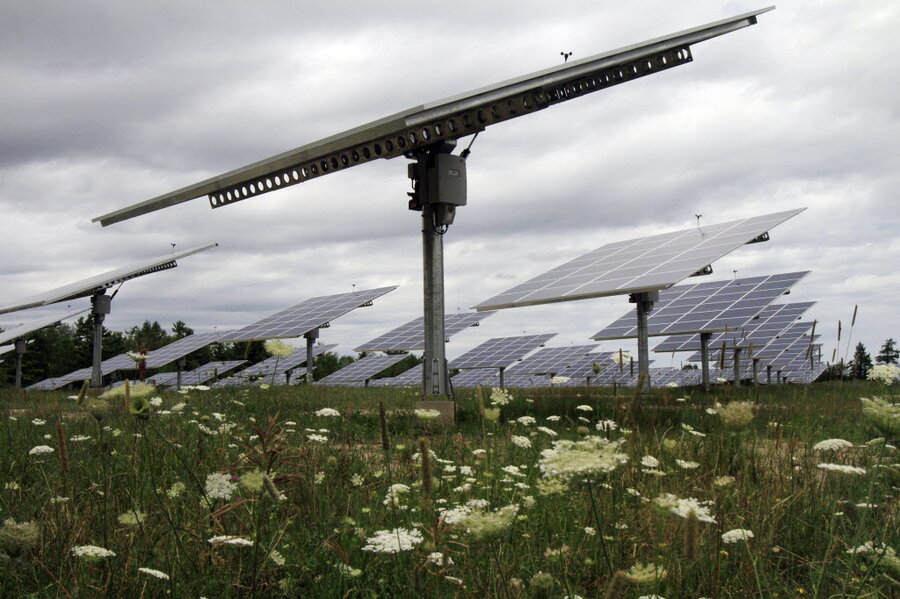The hidden virtuous cycle of Paris climate pledges
Loading...
The act of cutting greenhouse gas emissions can drive down the cost of further emissions cuts. This return on emissions reductions can be astonishingly large but has received limited attention thus far during the Paris climate talks (COP21). It should feature prominently in efforts to broker an ambitious, long-term agreement among nations.
Renewable energy demonstrates the phenomenon. Wind and especially solar energy costs have dropped precipitously as climate policy-supported markets for these technologies have grown at rates far exceeding forecasts. Just over the last 15 years, solar module costs have fallen by roughly 85 percent. Wind electricity now competes directly with coal electricity in many locations, and solar energy does in some places as well, particularly when accounting for the costs of respiratory, heart, and other diseases caused by air pollution.
Emissions pledges made in advance of this year’s climate summit could mean considerable further progress. In a recent report, my colleagues and I estimate that the solar and wind power capacity installed globally could grow by factors of nearly five and three, respectively, between now and 2030. As markets expand, costs are expected to drop further, by up to 50 percent and 25 percent for solar and wind, allowing these technologies to increasingly compete with coal and natural gas.
The reason: a virtuous cycle of technological innovation. Innovation happens at many stages of a technology’s development: public research and development (R&D), early private sector investment, and deployment are all important.
Governments from twenty nations have just announced their intention to double research funding for clean energy, and a group of the world’s wealthiest investors promised to help new technologies go from the lab to the marketplace. These commitments mean a huge and vital boost for the early stage development of low-carbon technologies.
Just as important for driving innovation and cost reduction – but less widely recognized – are the policies that spur increasing deployment and market growth. A common misconception is that new technologies discovered through research are then simply deployed as is.
Yet years of research, going deep ‘under the hood’ of technologies to understand why costs are actually falling, demonstrates the indispensable role of sustained deployment in supporting ongoing innovation. In the case of solar and wind energy, market growth was largely driven by government policies to reward emission-reducing technologies, but it unleashed the ingenuity of private companies in research, and in achieving economies of scale and greater productivity.
For example: engineers, technicians, and managers in solar fabrication facilities learned over time how to save materials and time, and to avoid the mistakes that would require them to scrap silicon wafers. Growing markets led to an appetite for investments in much larger manufacturing plants that save money per solar panel produced. Learning how to build burlier wind turbines, and pack electric vehicles chock-full with batteries, are other examples.
The benefits of market-creating policies have amassed with global efforts, building new knowledge that is expressed in better and cheaper technologies. This knowledge lasts indefinitely and, for technologies sold in global markets, can benefit citizens almost anywhere around the world. A family in Montclair, N.J. can install solar panels to reduce their monthly electricity bill because of manufacturing innovation in Baoding, China that was stimulated by taxpayer-supported market growth in Germany.
Some countries stand out for their contributions thus far. Japan led the world in total solar power capacity in the 1990s, and Germany took over in the early 2000s. The US, then Germany, and most recently China have led in terms of installed wind power. The US has invested more than any other nation in solar and wind research. In per-capita terms, an average Dane has played an outsized role in supporting the development of low-cost wind energy through growing markets.
If countries’ climate pledges made in advance of the Paris conference are met, China, the US, the EU, India, and Japan would all play leading roles in supporting further solar and wind market expansion globally. Many countries, from all six populated continents of the world, will contribute to developing clean technologies for electricity and transportation.
Both government-funded research and policy-driven market expansion of low-carbon energy are needed to address considerable innovation challenges that remain. New technologies for energy storage and demand management will be required if renewables are to continue to grow and maintain their value. A concentration of investments in fast-improving technologies should be delicately balanced by some portfolio diversification (not placing all eggs in one basket).
Sharing construction knowledge is also important. While hardware can be purchased in a global market, the ‘soft costs’ of installation vary across locations. International knowledge sharing – nation-to-nation and city-to-city – can help. Prizes or other incentives would stimulate the private sector to develop complete energy systems for low-cost installation anywhere in the world.
Because of progress that has already been made, these challenges now double as economic opportunities. Recent private sector interest is no accident; it is a direct response to growing market momentum.
Countries’ current emissions commitments are too weak to match the challenge of addressing climate change. But if countries’ pledges are realized, they will support the development of cheaper low-carbon technologies, allowing industrialized nations to increase their commitments (and less-developed nations to phase in their efforts) at lower cost.
This virtuous cycle should be one of the many compelling factors that gives countries the fortitude to act together on signing a robust agreement this week — one that includes a promise to intensify their emissions cuts over time.
Jessika E. Trancik is the Atlantic Richfield Career Development Assistant Professor of Energy Studies at the Massachusetts Institute of Technology in Cambridge, Mass.





